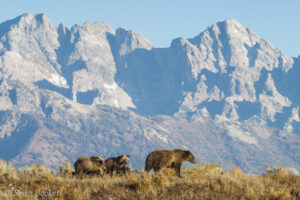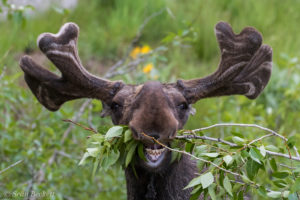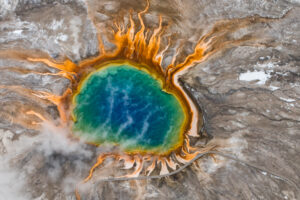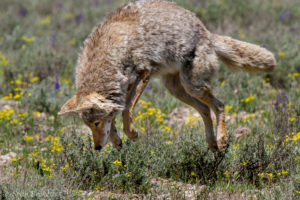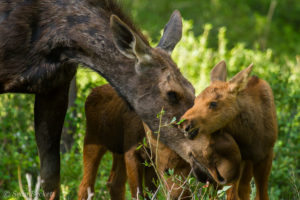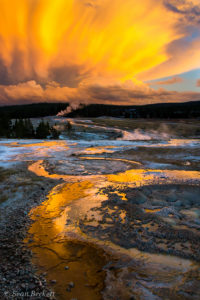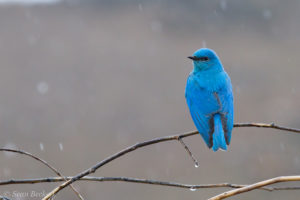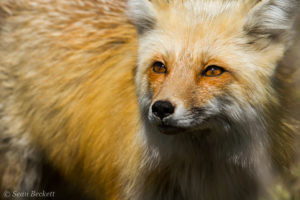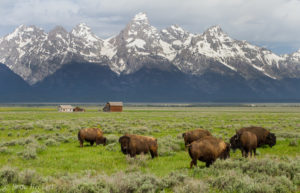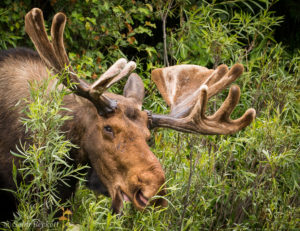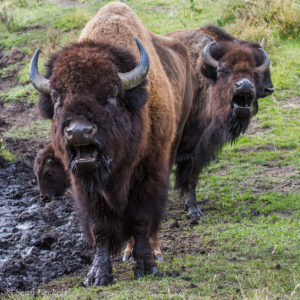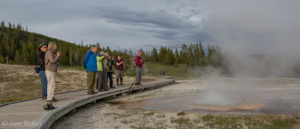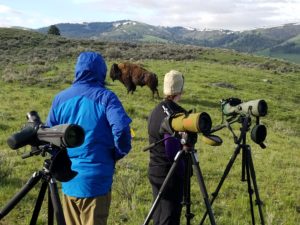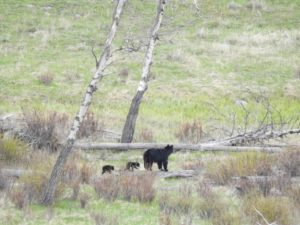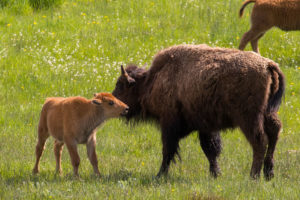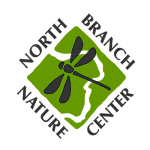Yellowstone & Grand Teton National Parks

June 14 - 21 2026
$4,600 per person (double occupancy)
$5,200 per person (single occupancy)
$500 deposit due upon registration
12 participants max
This special trip celebrates North Branch Nature Center's 30th Anniversary!
A s the sun rises over the Rocky Mountains, the sounds of bellowing elk, croaking sandhill cranes, and howling wolves resonate across the valley. Alone in the fragrant sagebrush meadows, you encounter a herd of mother elk and newborn calves grazing in the cool morning air. On the hillsides above, you focus your spotting scope on a pair of courting black bears in the fresh alpine wildflowers at the edge of a montane glacier. Nearby, steam rises from the edge of a simmering hot spring as a great gray owl hunts in the nearby meadow. Bison and grizzly tracks skirt the orange and turquoise rim of the bubbling pool. On this week-long safari into the heart of the wild, find out why the 18-million-acre Greater Yellowstone Ecosystem has been hailed as "America's Serengeti," "The World's Wonderland," and "The Land of Fire and Ice.”
Additional Information
Physical Requirements: Participants should be able to hike 3-4 miles per day on moderate terrain, and be comfortable with early mornings (we will generally depart our lodging at or before sunrise). Participants should also be comfortable riding in vans for long periods of time.
Climate: Yellowstone is one of the most spectacular yet extreme climates on the continent. Temperatures may range from low 30s to high 70s, and we can expect to see sun, rain, and maybe even a little snow.
Health Considerations: This itinerary takes place between 4,000 and 8,000 feet above sea level. While this altitude is rarely hazardous, participants with a history of altitude sickness or other altitude-related conditions should consult their physician for precautions. Dehydration and sun exposure are common issues in the arid Rocky Mountains. Please come prepared to drink plenty of fluids and wear sunscreen. There are no travel-related medications typically recommended for travel to this destination. Tap water is safe to drink throughout the trip.
Transportation: The land transportation will be done in two 12- to 15-passenger vans. We have limited the maximum capacity of this trip to 12 participants to allow for more space and comfort in the vans.
Wildlife: While we make every effort to spend each day seeking the most incredible wildlife viewing opportunities that the Greater Yellowstone Ecosystem offers, there is no guarantee of seeing particular species. Wildlife is capricious and unpredictable, and though your trip leaders know where to find areas and habitats with the greatest likelihood of encountering wildlife, there is always an element of uncertainty. While we cannot always predict what we see, we can promise many unforgettable wildlife encounters throughout the adventure.
This trip is led by NBNC Program Director Sean Beckett and NBNC Executive Director Naomi Heindel.
Sean has guided wildlife safaris and birding trips across North America for the last 15 years, primarily in Yellowstone and Grand Teton National Park. His experience as a top-tier Yellowstone and Teton guide is complemented by a background of wildlife research work in the Rocky Mountains that ranges from owls to deer to cougars. Sean holds a M.S. from the University of Vermont's Field Naturalist program.
Naomi has two decades of experience as a wilderness trip leader, including leading extended winter camping, canoeing, and backpacking trips in Yellowstone, Yosemite, and Grand Teton National Parks. Naomi worked as Director of Field Education at Teton Science Schools, where she oversaw a team of educators that immersed youth from around the country in place-based and nature-based experiences in the Tetons. She holds a Master of Environmental Science from the Yale School of the Environment.
Our accommodations range from rustic cabins to motel-style lodges. We selected lodging that positions us for the best possible wildlife viewing opportunities, while ensuring a clean, warm, and comfortable place to spend the night. In Grand Teton National Park at Teton Science Schools, each rustic room includes a full-sized bed and a twin bed. In Gardiner, each room is a suite that includes two queen beds.
As our goal is to be immersed in nature for as much of each day as possible, our lodges have been selected to accomplish this both financially and programmatically. Lodging costs have become extraordinarily expensive around US National Parks in recent years, and we've done our best to balance lodging price and quality.
Meals are also chosen and scheduled to maximize our time in nature. Meals will be a combination of picnic-style and restaurant options. Dinners will typically be at restaurants near or at our lodges. Breakfasts and lunches will often be picnic-style in the field. Most of our meals in the Tetons will be taken at the Teton Science School's dining hall. While we do our best to select high quality restaurants, please understand that our options are often limited due to the remoteness of our destinations.
Includes:
- Lodging accommodations
- Meals
- Transportation in two 15-passenger vans
- Park entrance fees
- Two expert naturalist guides
- Binoculars and shared wildlife spotting scopes
- Transfers to and from the airport
- Pre-departure orientation night (usually virtual)
Excludes:
- Airfare
- Travel and medical insurance
- Alcohol
- Gratuities
- Items of a personal nature
Ready to go to Yellowstone?
Email Sean@NorthBranchNatureCenter.org to get signed up.
Payment Schedule
- A $500 deposit is required to reserve your space on the trip.
- 50% of the trip balance will be due 6 months before the departure date.
- The remaining trip balance will be due 3 months before the departure date.
All payments can be made via ACH withdrawal, or by check. Credit card payments will incur a 3% surcharge.
Cancellation Policies
We understand that incidents and emergencies arise that may force you to cancel your trip. However, NBNC invests considerable time and, in many cases, non-refundable payments to lodges and local contractors to secure our rooms and programming. NBNC aims to be as flexible as possible in our refund policy, but a full refund of your payments may not be possible after the dates indicated. All cancellations must be made via email to NBNC.
-
Cancellation more than 180 days before the trip: Full refund of all payments.
-
Cancellation 90-180 days before the trip: Refund of any payments minus the $500 deposit. If your space is filled by another traveler, we will also refund your deposit.
-
Cancellation 30-90 days before the trip: No refund guaranteed. If your space is filled by another traveler, we will provide a full refund minus the $500 deposit.
-
Cancellation less than 30 days before the trip: No refunds guaranteed.
- Please see our COVID-19 page for NBNC's full policies surrounding COVID and other illnesses.
- All participants and instructors will be required to affirm negative test results from a self-administered Covid-19 rapid antigen test taken prior to arrival on the first day of the program.
- Participants on NBNC’s Adventures Afar and multi-night overnight trips must be comfortable with the possibility that someone on the trip may contract Covid-19 (or other contagious illnesses) during the trip, even if they test negative on the first day as required. NBNC will attempt to limit exposure and isolate any such participant, which could include that participant incurring additional expenses such as hotel rooms, meals, or transportation, and missing out on group activities. However, isolation may not be possible at all times on all trips, so all participants should be aware that circumstances may require that a participant with Covid-19 continue to travel with the group.
- Participants experiencing respiratory symptoms will be required to wear a mask at all times when around other travelers.
- Failure to comply with the health and safety instructions of the trip guides will result in dismissal from the trip.
- NBNC encourages all Adventures Afar participants to be honest and transparent about their symptoms, for the sake of their health and the health of those they are traveling with.
- NBNC encourages all Adventures Afar participants to secure individual travel insurance.
NBNC is proud to announce that all of our trips from 2025 onward are 100% carbon-neutral. This includes each traveler's flights to and from this destination, as well as carbon emitted during the trip.
How it Works: The voluntary carbon market has come under intense scrutiny in recent years as the legitimacy and effectiveness of many carbon offsetting projects have been called into question. That's why we're proud to be working directly with the Northeast Wilderness Trust's Wild Carbon program. The carbon credits we purchase to offset our carbon emissions are used to permanently conserve forestland as wilderness. Why wilderness offsets?
- It's Permanent: Unlike most contracts in the voluntary carbon market that have a lifespan of just 10-20 years, wilderness conservation is forever.
- It's Additive: Acreage purchased and conserved through wild carbon offsets would not be protected anyway through another mechanism later.
- It's "Leakproof:" Forest protection often just shifts and concentrates timber harvest elsewhere. But wilderness conservation is different–wilderness protection here doesn't just move carbon emission over there. That's because old forests function very differently than young ones. Big trees and old soils capture and store vastly more carbon than a young forest of the same acreage. Growing an old forest is like building a natural carbon sequestration factory!
- It's More than Carbon: With wilderness protection comes additional co-benefits like biodiversity conservation, flood resilience, and habitat connectivity. This way, going carbon-neutral isn't just negating our carbon footprint, it's also actively helping conservation in other ways.
Want to learn more?:
- Read The Ecotourism Dilemma, our article on how we think about carbon emissions in the context of nature travel.
- Check out this FAQ for NBNC travelers about Northeast Wilderness Trust's Wild Carbon Program.
- To learn more about forest carbon storage, please watch Understanding Forest Carbon by climate forester Dr. Ali Kosiba.
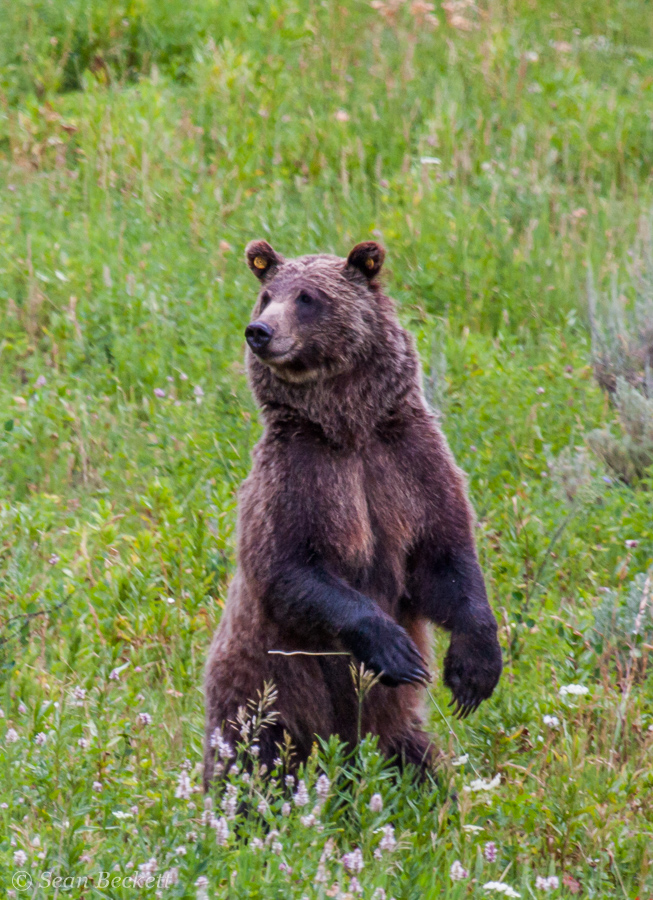
Detailed Itinerary
Day 1 – Arrival and Welcome Dinner
Our flights land in Jackson Hole, the heart of the wild west. As our plane taxis across the sagebrush prairie, we may glimpse our first pronghorn antelope or golden eagle right from the tarmac. For the next four nights we’ll be hosted by Teton Science Schools, a world-renowned nexus of environmental education right in the middle of Grand Teton National Park. A centerpiece of western natural history and conservation legacy, our rustic lodging is situated in a major wildlife movement corridor and features unparalleled views of the sunset over the Tetons. After an orientation dinner, we’ll wind down to the sound of coyotes howling in the hills.
Day 2 and 3 – Wildlife Watching in Southern Grand Teton NP
We’ll depart early these mornings to search for magnificent wildlife as a golden sunrise illuminates the glowing Teton range. Moose, coyote, bears, and bison are among the 61 species of mammals in Jackson Hole that we’ll pursue. After full mornings of wildlife viewing, we’ll explore cultural, historical, and ecological landmarks of Jackson Hole, such as old settler farmsteads, famous viewpoints, or the historic cabin of two of the 20th century’s most influential naturalists, Olaus and Mardy Murie. The Murie Ranch is a place of magical conservation legacy that has welcomed and inspired environmental leaders from Aldo Leopold to Jane Goodall for nearly a century. We’ll also hike into the backcountry in search of songbirds, raptors, and wildflowers, returning to Teton Science Schools for a hearty dinner, followed by a campfire, stargazing, or evening birding.
Day 4 – Wildlife Watching in the Northern Tetons
Our adventure continues today in the northern reaches of Grand Teton National Park. Here we may witness newborn elk calves among the large herds that frequent the expansive willow flats, or even glimpse a grizzly bear hunting in the meadows. We’ll enjoy sandhill cranes, trumpeter swans, and American white pelicans foraging in the foreground of America’s most spectacular vistas. Spring wildflowers will also be coming into peak bloom this time of year, and the northern part of the park features stunning wildflower displays.
Wildlife watching in Grand Teton and Yellowstone National Parks is much like sitting down for a stage performance. We never know what we will see on a given day, but it is always breathtaking. Your guides are trained to be in the right place, at the right time, for the show to unfold.
Day 5 – Into The Heart of Yellowstone
Today we leave the Tetons and work our way north across the entirety of the Yellowstone plateau. We turn our attention away from wildlife momentarily as we encounter our first hot springs, steam vents, and geysers. Yellowstone sits atop a massive volcanic hotspot that drives this rare and powerful geothermal activity. We'll visit Old Faithful, and witness the excitement of the crowds assembling from across the planet to see one of the most stunning performances in nature. Old Faithful is located within the Upper Geyser Basin, a mile-wide feature that comprises a sizeable portion of the planet's geysers and hot springs. We'll take a walk on the quieter trail loops, and get up-close and personal with dazzling, rainbow-colored pools, quirky, spitting mudpots, and vents that toot like a boiling kettle.
From here, we leave Yellowstone’s volcanic interior plateau and descend into the park’s wild Northern Range. This breathtaking million-acre expanse of valleys and mountain ranges contain some of North America’s premier scenery and wildlife watching. At the corner of the Northern Range, we'll settle into the small gateway town of Gardiner, Montana, where we'll enjoy a meal and a comfortable bed after a long day.
Days 6 and 7 – America's Serengeti
Over the next two days we will immerse in the wildlife spectacle of the Northern Range. We'll wade through herds of mother and baby bison (from the safety of our vehicles!), watch pronghorn racing along the ridges, and search for black bears and grizzlies foraging in the lush grasslands. The region is also home to Yellowstone’s most illustrious and elusive carnivore: the grey wolf. We’ll spend our afternoons exploring abandoned wolf dens, hiking to historic wolf re-introduction enclosures, and visiting other hidden destinations steeped in ecology and conservation history. We’ll also keep an eye skyward for prairie falcons, Swainson’s hawks, and great gray owls.
In the evenings, we return to Gardiner for dinner, and make the most of the evenings by watching the sun set over the Northern Range from secret and stunning promontories hidden along the old silver mining roads above town.
Day 8 – Departure
Our excursion concludes today, but even our drive to the Bozeman International Airport will reward us with many wildlife sightings as we travel north through the spectacular Paradise Valley, one of Montana's oldest and most fabled ranchlands, tucked in the palm of the rugged wilderness. As we head to catch our departure flight, we’ll reflect on the week and enjoy a panoramic view of the Gallatin Mountains in the morning light.
